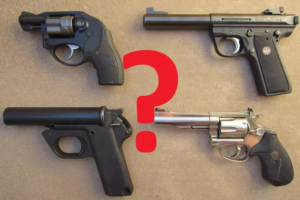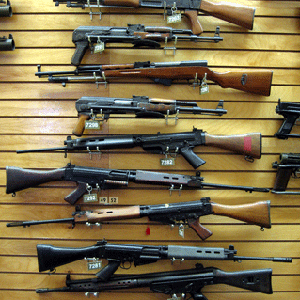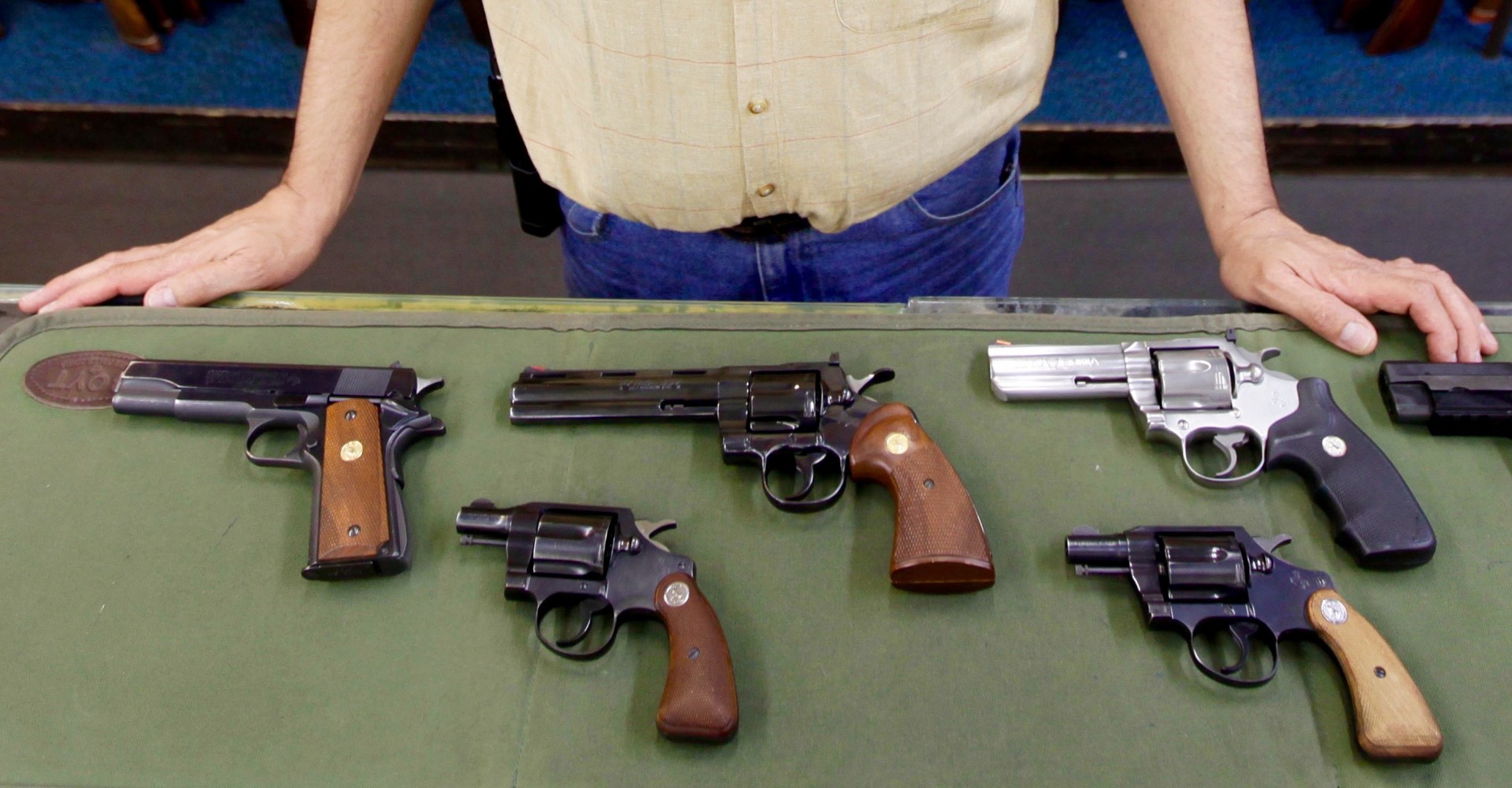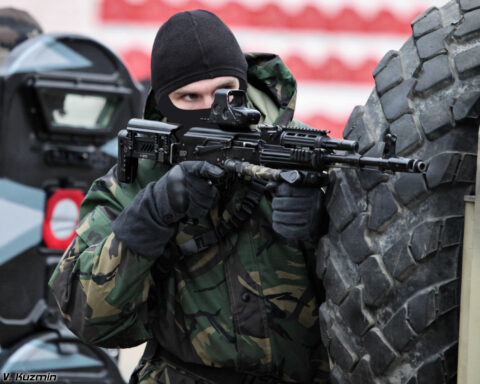Editor’s Note: We have been after our buddy, Lupine Nobilis, to write us up his thoughts on finding the right firearm. He is a worldclass expert on the topic, and every single one of our MOTW regulars has learned a lot from him. He finally obliged us. After reading, I am sure you will be clammering for more from him.
 One of the biggest debates (aside from the dreaded 45acp vs 9mm) in the firearm world is what the definition of a good gun is. If you ask 100 people, you’ll probably get 101 answers, and 90% of those are personal opinion. If X shooter likes Y brand or has had good experience with Z model, they’ll call it good. But opinion can be skewed and is open to interpretation.
One of the biggest debates (aside from the dreaded 45acp vs 9mm) in the firearm world is what the definition of a good gun is. If you ask 100 people, you’ll probably get 101 answers, and 90% of those are personal opinion. If X shooter likes Y brand or has had good experience with Z model, they’ll call it good. But opinion can be skewed and is open to interpretation.
So laying all opinion aside on makes and models, there are two main determining factors on what a good firearm is. There are two additional factors that conditionally apply.
But for now let’s focus on the main two. The main two factors that determine a firearm’s quality are reliability and accuracy. These are not conditional, nor are they interpretive. If a firearm does not function as intended, the rest doesn’t matter. Which is why reliability is first and foremost. The close second to reliability is accuracy. If your rifle always works, but never puts two rounds where you need them, then it’s a problem.
What makes a firearm reliable though?
Determining Factors
First and foremost, it has to work as described each and every time. For that to happen, it has to be made with quality components and assembled in a coherent manner. It has to have the proper tolerances within the pieces that allow for reliable use and function. It is fairly well known that Beretta, CZ, Glock, Steyr, and others have a solid reputation for reliable full-sized handguns. Most of these designs have been built and improved on for decades. What may not be known so well is that companies such as Canik and SAR make very solid pistols. This is because they have world class manufacturing facilities and maintain high standards on Quality Control.
What else would factor into a firearms reliability? Well it has to feed and function with a wide variety of ammunition. There are many handguns (22 mags come to mind) that will feed and function all day long, so long as you have X brand, Y load ONLY loaded in the magazine. Being finicky about ammo doesn’t instantly disqualify a firearm from being good. But it is a point of consideration, and it must be noted that there is a difference between a firearm needing a break in period and it just not liking X load.
When Ruger released their SR22 hand gun, they marketed and advertised it as the 22 that would eat most anything. The problem was they hadn’t really endurance tested it with lots of different rounds. When they hit the shelves (and gun ranges), people quickly found out that a lot of them preferred certain rounds (usually plated HP). Then when they got broken in, they actually got worse. It was a small matter to replace the plastic recoil rod & spring, but considering they were advertised to eat anything, they fell short of their own mark.
Lastly, for a firearm to be reliable it has to hold up to use. Not necessarily 5,000 rounds without a cleaning, but it has to handle a day of shooting 500 rounds with no issues. This gets back to being made by proper spec’d parts and assembled correctly. But it also leans into being able to run mucked up, and easy to clear and clean. Most rimfire firearms are notoriously dirty. It’s the nature of the round, lots of unspent powder fowl the chamber, which can prevent proper function of the firearm. Too often I’ve seen 22’s gummed up because of improper maintenance or just sheer neglect. Old Mark 2 Ruger handguns are notorious for being coated in powder and muck. The main reason is because the Mk2 and Mk3 are not easily disassembled. Most people know that, so if they run a brush and patch through the barrel, and spray something in the chamber, they’ll call it good. There were firearms produced in the 90’s that actually said for the owner to not try to disassemble them. You were supposed to send them back to the company, pay them a “nomenal fee” to have them tear your firearm down and clean it. That is a very large red flag. If you can’t easily clean and maintain your firearm, it will get mucked up. Especially if you train with it as you should. If that $1,000 handgun ran like a top when you first got it, but now Fail to Fire/Feed (FTF) or Fail to Eject (FTE) every mag now because it’s never been clean. It is not reliable. If it’s not been cleaned due to your neglect, that’s your fault. If it’s not been cleaned because it can’t, that’s poor design and their fault.
So now let’s say you have X firearm. It eats everything you feed it. Functions without exception. and it’s easy to clean and maintain. Great!
But what if said firearm couldn’t purposely place two rounds in the same place? What if every third or fourth round you have a random flier striking two feet high, or three feet left or a foot and a half right?
If you cannot hit your target, the purpose of the firearm is void.
So let’s focus on accuracy. There are two variations of this. There is mechanical accuracy, which is what the firearm will do when all human elements are removed. Generally, they can be placed in a weighted ransom rest and locked down. For a firearm to be considered mechanically accurate, it has to place shots on paper consistently and within standard deviation. Most modern handguns can achieve 1.5-2″ groups at 25 yards with standard ball ammo. Most rifles can achieve 1.5-2″ groups at 100 yards (there is a big call for rifles to be 1MOA or Sub MOA accurate these days. MOA stands for Minutes of Angle which is just a little more than 1″ at 100 yards. Many off the shelf rifles can achieve this, but for accepted industry standards 1.5-2″ is more of a realistic target, especially with ammo variances).
The second aspect of accuracy is shooter or user accuracy. So now we have a firearm that is reliable, it eats any type of ammo you throw at it. It functions like a sewing machine, smooth and rhythmic. It can handle a bit of abuse and use, and it’s easy to clean and maintain. It also shoots solid 5 shot group cloverleafs at 25 yards. Great, but can you hit with it?
I list this last because it can be conveyed as opinion, but really it’s not. Its interpretive to the individual. I cannot say what’s good for me is also good for you. But what can be said are the basics.
It must have good sights on it. They need to be clear to your eye, and in some way adjustable. What if that Eater-of-All-Cloverleaf-Making sewing machine prints two feet right because the sights are misaligned? Sight alignment and trigger discipline largely affect end user accuracy, so I’m leaving that aspect out of this. I’m simply talking about sights that are off. If you have fixed sights such as on some pocket pistols or revolvers, well good luck. You can learn to shoot it accurately. (I have an old Colt Frontier Scout that the front sight is basically at the 1:30 position, not 12. After thousands of rounds through it, I can hit what I want. However, anyone else were to ever pick it up – not so much). You need to be able to clearly see and adjust your sights. If that firearm is shooting two feet right every single time you pull the trigger, then you need to be able to adjust to that and bring the group back on target.
Conditional Factors
The first conditional factor is that of cost. To some people, money is no object, and to others, it is a very, very important object. For a firearm to be considered good, it has to merit its cost. It has to have a reflective value where its price tag fits your needs and wants. Some people have no problem spending $10,000 on a custom bolt action rifle and never shooting it. Others want to strain every ounce of use out of $350 Canik TP9 they can. Some firearms companies market expensive firearms, banking on the name and reputation of the company to help sell them. Thus, some people feel that if they pay more for a firearm (or any item for that matter), it means it has to be better than the competition. This is a fallacy.
You have to have a stated and intended purpose for your firearm, and you have to be realistic with that purpose, both of use and cost.
 Lastly, and most importantly, the firearm has to fit and work for you. That Eater-of-All-Cloverleaf-Making-dead on accurate firearm does you no good if you cannot use and manipulate it properly. This is why the very first and very best piece of advice given to people looking for a new firearm (especially handguns) is to go to a shop or a range and handle and manipulate as many firearms as you can. Then from the list that you can safely manipulate, shoot each of them to see how you handle them.
Lastly, and most importantly, the firearm has to fit and work for you. That Eater-of-All-Cloverleaf-Making-dead on accurate firearm does you no good if you cannot use and manipulate it properly. This is why the very first and very best piece of advice given to people looking for a new firearm (especially handguns) is to go to a shop or a range and handle and manipulate as many firearms as you can. Then from the list that you can safely manipulate, shoot each of them to see how you handle them.
A perfect example of this was demonstrated when I attended a particular action shoot. There was a lady that shot a CZ clone in 45 acp. It is widely accepted that CZ’s are solid pistols; they are durable, reliable, and accurate. However, for this lady, she struggled to keep 6 rounds within a 12″ plate at 7 yards. I started watching how she was shooting it. First off, you could tell the weight of the gun bothered her (as it was a steel frame, full sized pistol) as the gun swayed quite a bit when she was getting a sight picture. Additionally, she was struggling with follow up shots from the recoil. Then when she had to do a reload, it took her more time to adjust around the pistol because her hands were too small to manipulate the controls. Out of curiosity, I asked her to shoot one of my pistols. It was a simple Walther P22. While every shot was to the left for her, both mags were within a 2″ square at the same 7 yards. The lady could shoot, and she was competent with the function and manual of arms of a handgun, but the one she had at the time was just wrong for her. I found out some time later to her husband’s dismay, that she started shooting a 9mm CZ and IMHO was probably out shooting her husband.
So let’s get into more detail regarding the firearm fitting and working for you. First off, can you load and charge it safely? A few years ago, pocket guns were all the rage. The smaller the better, some thought. Except when you go to rack the slide. Most of those mouse guns in .380 or 9mm have very stiff recoil springs to offset the lack of weight of the frame and slide, to keep it from beating itself apart. If you cannot safely rack the slide on a pistol, then you need to look for something else. Additionally, you have to be able to safely reach and manipulate the magazine release (or cylinder release), the safety/de-cocker and any other controls on the arm. There are too many options available for people these days, than to have to have a pistol you have to use both hands to release the mag on, or trip the safety.
Just as important, you have to be able to consistently and reliably pull the trigger. Most revolvers, and some semiauto pistols, have a very stiff double action trigger pull. If the firearm trigger pull is so stiff you physically cannot pull it, then it is not safe to use for you. Some defensive handguns ship with a DAO or Double Action Only trigger. Kel Tec is notorious for making handguns with ridiculously stiff triggers. The PF9, while only about 15 ounces fully loaded, has an advertised 5lbs DAO trigger. Honestly, they’re being modest, as I’ve seen triggers from 7-12lbs. A lot of people simply cannot manipulate a trigger pull that stiff and still be safe with the gun, much less accurate. A striker fired, or SA action will serve them much better.
Right now, it’s a buyer’s market, and we have more quality options available to us than ever before. With these factors in mind, you can make a sound purchase for a good firearm to apply to your use and purpose.

What Makes A Good Firearm?
4 Comments
Leave a Reply
Latest from Firearms

The Weimar Years – Part 5
Summary of the German Revolution, 1918-1919.

Ukraine, NATO, and the End of the Postwar Order
Russia is massing troops on the Ukrainian border. America is threatening sanctions or worse. Britain warns of war, while Germany wants peace. Is the post-WWII geopolitical order crumbling? Will Russia always be

The Commies Are Coming
The Commiecrats in congress have shifted their focus to gun grabbing. As they are writing their bill, and just a few days after a Colorado judge shot down a case that would
Molon Labe
Come and take it, you commie bastards.

One Night in San Antone: Ben Thompson (Part 2)
In the period now beginning, Ben drank more heavily than ever. He became a common nuisance to both his friends and his enemies; particularly perhaps, to his friends. Even his most indulgent




5
Good article.
If one where only looking for pistols I would probably say reliability and fit are the primary concern. Accuracy in handguns is not much of a problem, especially if you stay within the major respected manufactures. Is it accurate? The stock answer is almost always yes, it’s more accurate than you’re capable.
A low bore axis is a must have.
DA/SA sucks.
Generally yes, that’s why I prefer to separate mechanical accuracy from user accuracy. It can be clover leaf accurate, but some people just can’t shoot certain pistols well.
Low bore axis is great to have, except to follow your 2’nd statement a lot of the really good ones are SA/DA. Which I’ll happily agree DAO is horrible, but DA/SA has a place.
Thing is, in a lot of ways striker fired handguns have spoiled the shooting masses. There are some SA/DA that have tolerable DA and really good SA, plus the restrike feature isn’t real popular these days. So, its extra insurance for a light strike or the like.
I generally preach KISS to people, and DA/SA just adds a layer of complexity that is unnecessary, especially with the vast majority of shooters who are going to rarely practice.
I realized long ago to be really good I was going to have to train my brain to do all of the mechanical manipulation of the gun at the subconscious level. I then concluded that the simpler I kept the equation the easier it would be to program my mind. Thus I sold all of the various types of pistols I owned and now only own one type.
The only thing I would add is there is a lot of merit in, once you figure out what works for you, eliminating all other types, if your focus is on being good.
Shooting is a software problem once you find a reliable pistol that fits you well.
Again, really good article, all signal and very little noise.